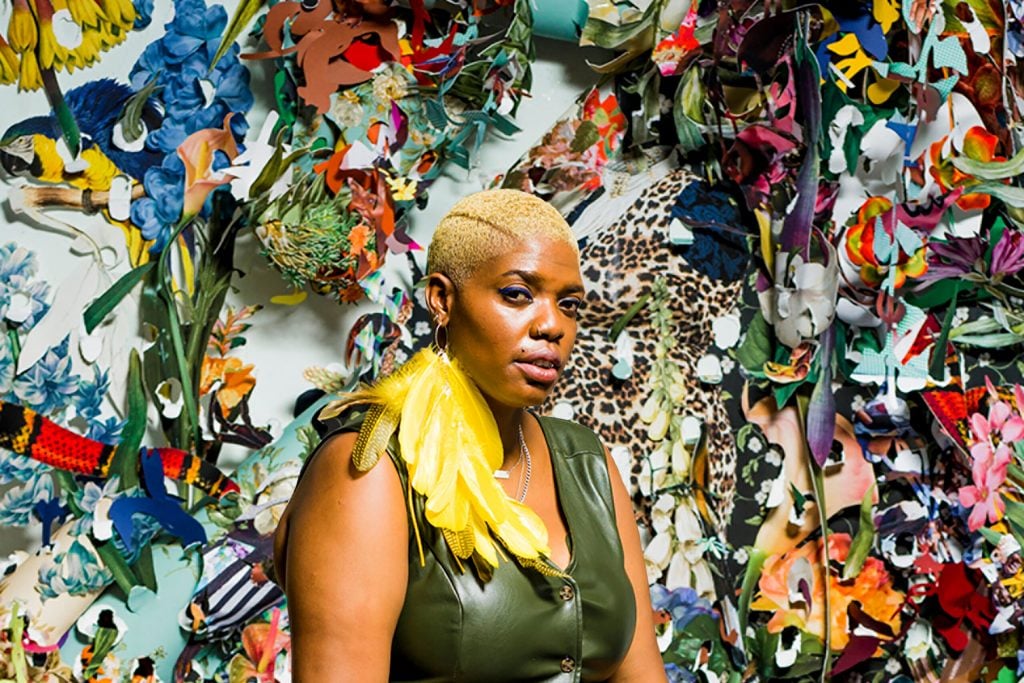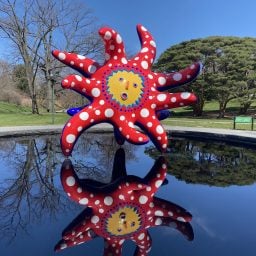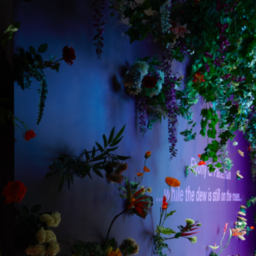Growing up in Jamaica, Ebony G. Patterson (b. 1981) saw turkey vultures everywhere. “We call them John Crows,” the artist, known for her exuberant and unsettling works across multiple mediums, told Artnet News.
Now, she’s installed a flock of 400 larger-than-life sculptures of the scavenging birds on the grounds of the New York Botanical Garden (NYBG), the centerpiece of her recently unveiled exhibition, “…things come to thrive…in the shedding…in the molting…” Although the NYBG has presented such artists as Yayoi Kusama, Georgia O’Keeffe, and Dale Chihuly as part of its seasonal arts programming, Patterson’s site-specific exhibition is actually the culmination of a yearlong immersive residency at the Bronx institution—the first ever granted to an artist.
The show is a rumination on transitory states, and how death and decay—and the titular shedding and molting—can become a step toward regeneration, healing, and even beauty. The vultures, in particular, are a metaphor for Black women, inspired also by the Three Marys in the Christian gospels (the Virgin Mary, Mary Magdalene, and Mary of Clopas).
“I was thinking about these three women who came to Christ’s tomb to discover that the body was gone, they all came out of an act of love. And then also thinking about like the presence of women, [in the wake of] police violence,” Patterson said. “In working-class communities, quite often, it’s the voices of women that come to represent the bodies that are on the ground. Men die, women cry.”
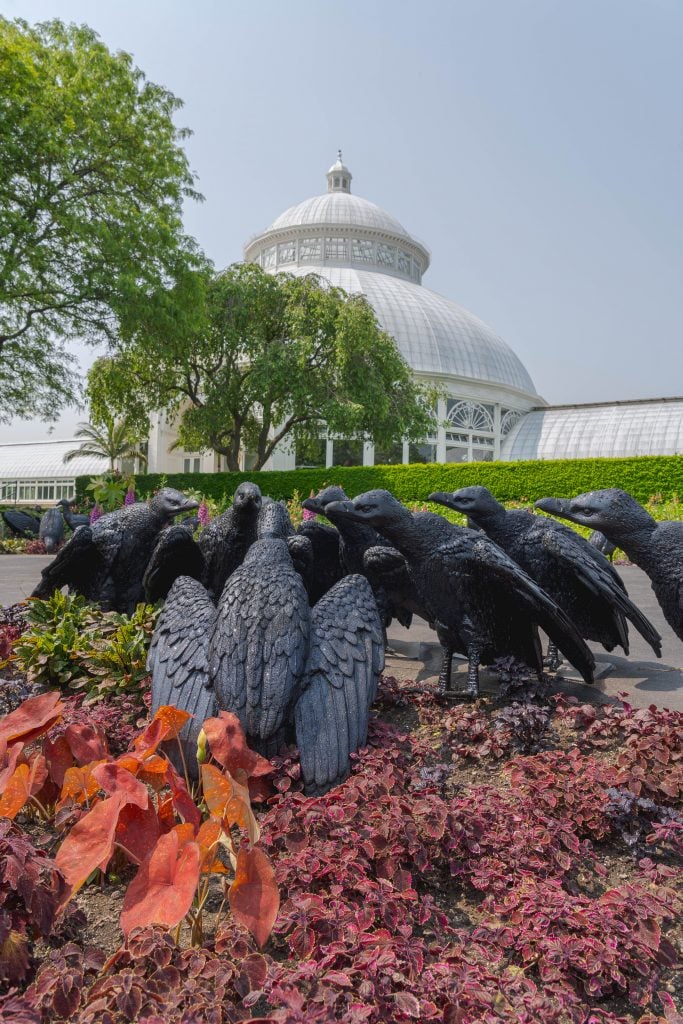
Installation view, “Ebony G. Patterson: …things come to thrive…in the shedding…in the molting….” at the New York Botanical Garden. Courtesy of the New York Botanical Garden.
“And the vultures come as an act of love, too. It’s an act of care. They come to consume the body, so that new life is possible,” she added. “It’s all the work that nobody wants to do. And when one think thinks about the vulture metaphorically, as it relates to the way we operate as a society, who are the people that have to do the labor that we don’t want to do? It’s all working-class people of color. Throughout history, it’s always the same set of bodies that are exploited.”
Tackling dark themes related to social and political injustice via brightly colored, flowery artworks rife with beads, rich fabrics, and other ornamentation is a signature of Patterson’s practice. At the garden, the physical landscape becomes an extension of her canvas, a riot of green and yellow, pink and red, along with dark purple and burgundy flowers and plants that the artist used to create what she considers “wounds” in the earth.

Installation view, “Ebony G. Patterson: …things come to thrive…in the shedding…in the molting….” at the New York Botanical Garden. Courtesy of the New York Botanical Garden.
“She’s creating a blood-red landscape with cuts slicing into the land with these beautiful red and black plants,” her gallerist, Monique Meloche, told Artnet News. “Ebony uses beauty to talk about postcolonial violence against Black and brown bodies.”
Those histories are present even in the Bronx: the garden grounds are home to the nation’s oldest existing tobacco manufacturing building, the Lorillard Snuff Mill, built in 1840. But it wasn’t only the garden’s past that appealed to Patterson.
“She wanted to do something here in the Bronx because of the demographics. She wants this to be accessible to people who look like her,” Meloche added.
Patterson also thought about the ways that working-class people encounter gardens—in the names, perhaps, of low-income housing buildings in her native Jamaica that seem designed to evoke a kind of colonial nostalgia about gardens, but stand in stark contrast to the manicured landscapes at wealthier properties.
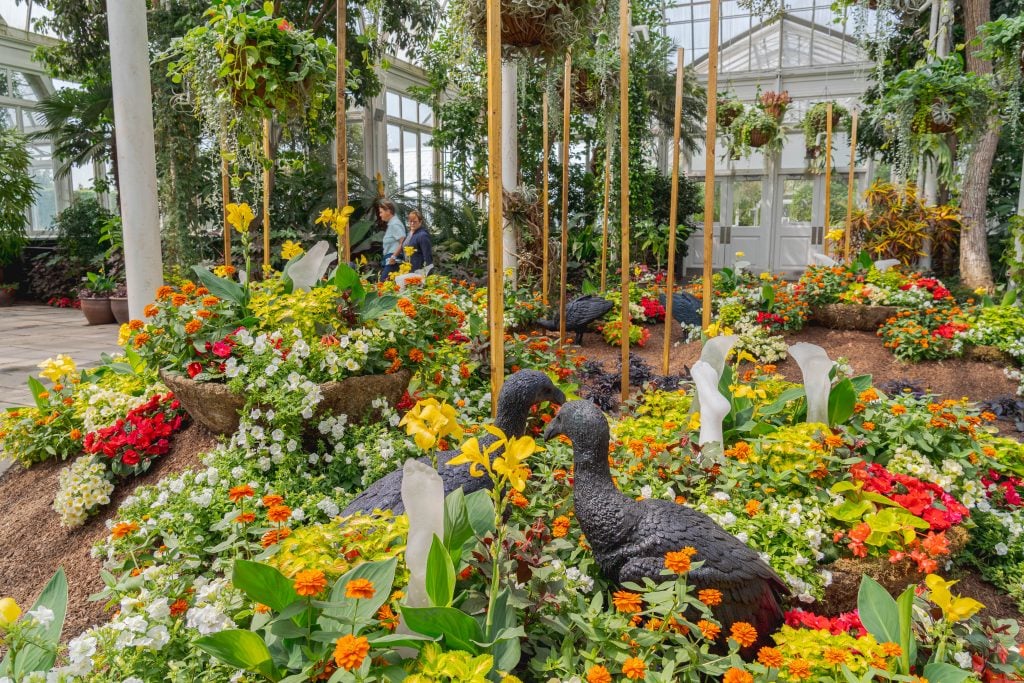
Installation view, “Ebony G. Patterson: …things come to thrive…in the shedding…in the molting….” at the New York Botanical Garden. Courtesy of the New York Botanical Garden.
“What does it then mean to think about gardens as they relate to communities that are given particular kinds of care?” Patterson asked. “And then also, what does it then mean to think about those gardens that are not given consideration for possibility of care, but thrive regardless—because that is what happens in nature, right?”
After years of working with silk flowers, “…things come to thrive” marks the artist’s second project with living plants, following a garden she planted during a residency at the Momentary at the Crystal Bridges Museum of American Art in Bentonville, Arkansas. A mix of poisonous and medicinal plants, the garden was planted and then left untended.
“It was a garden that was just meant to live and die. It had one watering,” Patterson said. “In the end, what started happening was all of the things that had poisonous properties started to die, and the plants that had healing proper started to thrive. It was such an incredible metaphor.”
In New York, Patterson wanted to call attention to the constant maintenance of the botanical garden and its grounds, and the illusion of continuous life created by constantly replacing seasonal blooms throughout the year. (It also took the staff a year to grow all the plants in the exhibition.) Her garden is planted with plenty of specimens that will thrive in the summer heat, but also varieties that will stay in the ground even after their peak beauty.

Ebony G. Patterson at her exhibition “…things come to thrive…in the shedding…in the molting….” at the New York Botanical Garden. Courtesy of the New York Botanical Garden.
“Normally in a cultivated garden, you take the spring plants out, but for this we’ll let them decay and go to seed,” Brian Sullivan, the NYBG’s vice-president for gardens, landscapes, and outdoor collections, told Artnet News. “We’re trying to do as little intervention as possible in this garden. It is a really fun experiment for all of us.”
It has also meant a new way of working for the artist.
“Ebony works alone in the studio. She finally has one studio assistant, but that studio assistant does nothing but like, the glitter. And so for Ebony to like give over a lot of her process to all of the wonderful staff here at the botanical gardens was just this amazing thing,” Meloche said, expressing her hope that Patterson will allow herself to begin working with a bigger team.
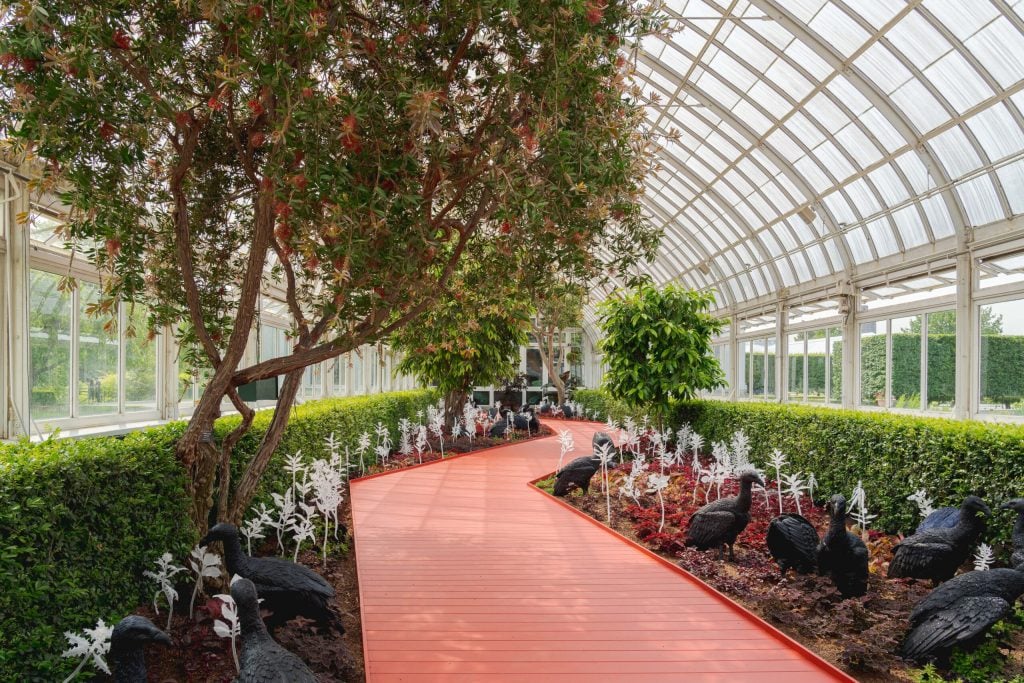
Installation view, “Ebony G. Patterson: …things come to thrive…in the shedding…in the molting….” at the New York Botanical Garden. Courtesy of the New York Botanical Garden.
The show also features delicate glass flowers, hand-cast from extinct plants Patterson encountered as specimens in the NYBG herbarium, on which she worked with fabricators in Philadelphia, New Jersey, and Oregon.
“Many of many of these plants were collected only once or twice offered by amateur scientists before they were lost forever. These herbarium specimens are some of the only evidence we now have of these once- thriving plants,” NYBG president Jennifer Bernstein said at the exhibition’s opening. “The pale, almost bone-like quality of the glass sculptures that Ebony has created in memorial of several of these extinct plants seem like ghosts or skeletons.”
Fittingly, the artist has paired these frosted blooms with glass bones and vertebrae. In the Enid A. Haupt Conservatory, a wake of vultures (the official name for a group of the birds when feeding on carrion) approaches a pair of glass legs resting in the reflecting pool and protruding out from a wall of dark leaves.
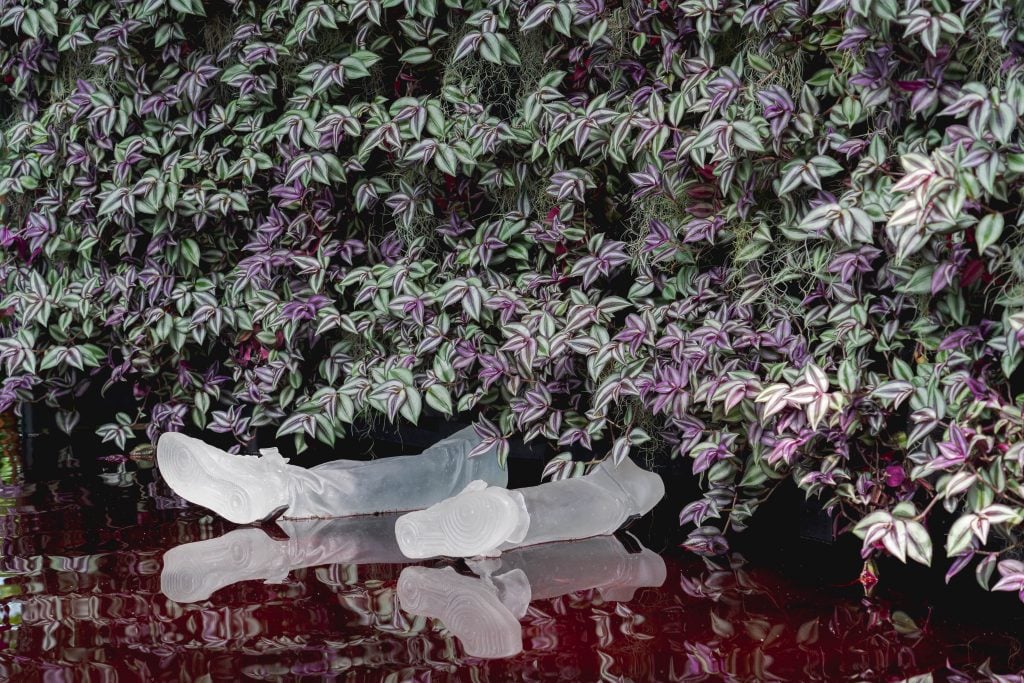
Installation view, “Ebony G. Patterson: …things come to thrive…in the shedding…in the molting….” at the New York Botanical Garden. Courtesy of the New York Botanical Garden.
In the adjoining room, the vultures are joined by a magnificent white peacock, a sculpture inspired by an encounter with one while it was in the process of molting, a creature known for its magnificent plumage captured at its ugliest and most vulnerable. An eerie soundtrack plays in the space, featuring Patterson intoning the exhibition title and the cycle of death, mourning, and rebirth.
“I’m packing the garden in a moment of molting, in a moment of transformation,” she said. “It’s about witnessing our collective ugliness, that even in the ugliness, beauty is possible. In that possibility, we will always find new ways ahead.”
In addition to her installations on the grounds and in the conservatory, Patterson is also presenting work in the garden’s Mertz Library. There’s a series of cut-paper collages made from botanical illustrations, a video work, and a new tapestry sculpture that Meloche said “Ebony thinks is the best work she’s ever made.”
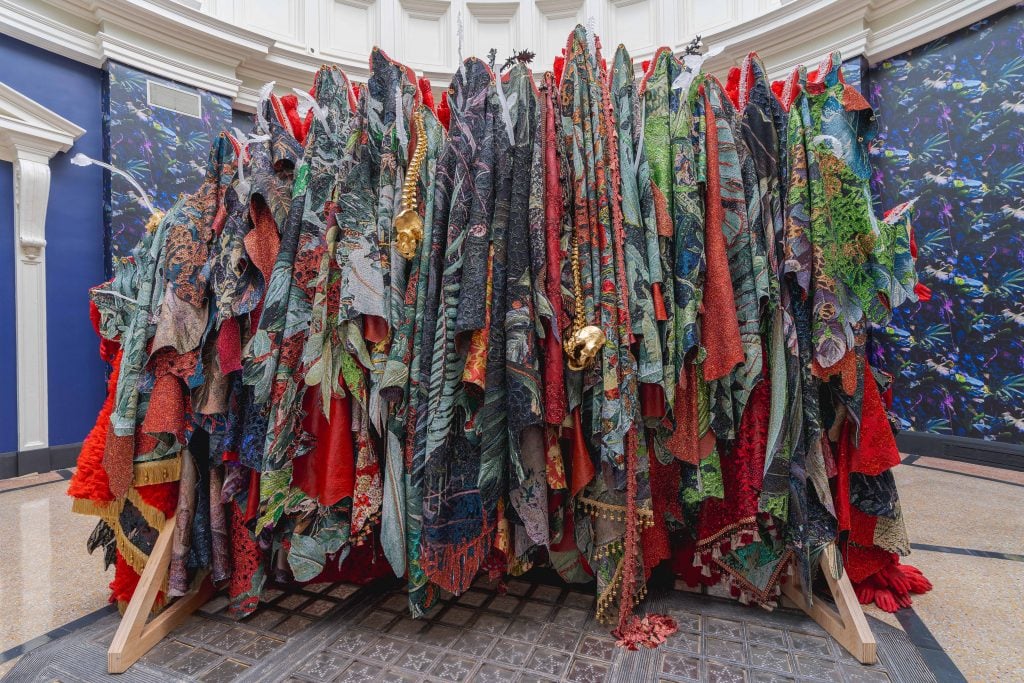
Installation view, Ebony G. Patterson, “…fester…,” at the New York Botanical Garden. Courtesy of the New York Botanical Garden.
The current exhibition is just one of many irons currently in the fire for Patterson. Her work is included in “Forecast Form: Art in the Caribbean Diaspora, 1990s–Today,” which closed in April at the Museum of Contemporary Art in Chicago and will travel in October to the Institute of Contemporary Art, Boston. She’s also working on a major solo show set to open at the Arnolfini International Center for Contemporary Arts in Bristol, U.K., in 2024, and is co-curating the Prospect.6 biennial in New Orleans with Miranda Lash of the Museum of Contemporary Art Denver, also for 2024.
“What went on here just cracked open another universe for Ebony,” Meloche said. “I’m super excited to see what happens next in the studio.”
“Ebony G. Patterson: …things come to thrive…in the shedding…in the molting….” is on view at the New York Botanical Garden, 2900 Southern Boulevard, Bronx, New York, May 27–October 22, 2023.
